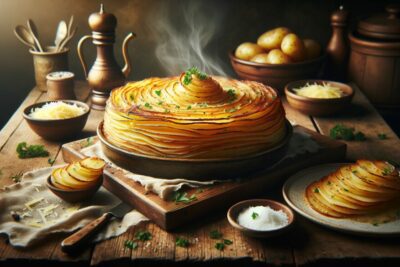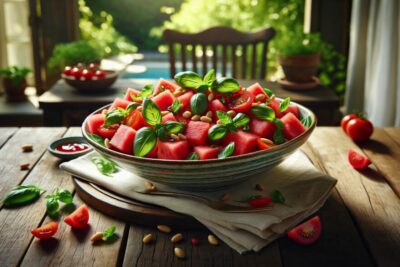
Discover the secrets to creating a light and crispy prawn and vegetable tempura with our easy recipe. Perfect for party appetizers, this dish brings a touch of Japanese elegance to your table.
Immerse yourself in the art of making delicious tempura that is as pleasing to the eye as it is to the palate. Follow our step-by-step guide to achieve that perfect golden crunch.
🔍 Seeking a breakthrough in Type 2 Diabetes management?
Discover our expert insights and innovative approaches on ‘How to Cure Diabetes’.
Click to transform your health journey today!
What you\'ll find in this article?
- How to make prawn and vegetable tempura
- Ingredients for prawn and vegetable tempura
- Tips for a light and crispy tempura
- Step-by-step guide to perfect tempura
- Variations and serving suggestions for tempura
- Common mistakes to avoid when making tempura
- Prawn and Vegetable Tempura: Questions and Answers
How to make prawn and vegetable tempura
Creating the perfect prawn and vegetable tempura is an art of balance and technique. The key is to use ice-cold water for the batter and to fry at the right temperature. Ensure your prawns are shelled and deveined, and your vegetables are sliced to an ideal thickness for even cooking.
Start by whisking your batter until it's just combined - lumps are actually a good sign here! Heat your oil to 350°F (175°C) and dip your ingredients into the batter, then gently lay them in the oil. Fry until they are lightly golden and drain on a wire rack.
Remember, the batter should coat your ingredients thinly, forming a delicate shell that crisps up quickly in the hot oil. This technique will give you that coveted airy crunch that is characteristic of authentic tempura.
Explore our specialized services in diabetes care 🌟.
From personalized diet plans to effective exercise routines, we have what you need to take control of Type 2 Diabetes.
Visit our services page now!












Ingredients for prawn and vegetable tempura
The ingredients for prawn and vegetable tempura are simple yet crucial for achieving that irresistible crunch. You will need:
- Fresh prawns, peeled and deveined
- Assorted vegetables like bell peppers, sweet potatoes, and broccoli
- Ice-cold water to create a light batter
- Tempura flour or a mix of all-purpose flour and cornstarch
- A pinch of salt
Select vegetables that will cook quickly and complement the delicate flavor of the prawns. Cut them into bite-sized pieces to ensure they cook evenly.
Tips for a light and crispy tempura
For the lightest and crispiest tempura, keep the batter cold and don't overmix. Use carbonated water to add airiness to the batter. When frying, do not crowd the pan, as this will lower the oil's temperature and result in soggy tempura.
Another tip is to use a high smoke point oil like canola or peanut oil for frying. This ensures your oil won't break down at high temperatures, keeping your tempura light and crisp. Also, maintain your oil's temperature between batches by allowing it to come back to 350°F (175°C) before adding more tempura.
Step-by-step guide to perfect tempura
Perfecting tempura is all about understanding each step of the process. Firstly, prepare your prawns and vegetables, ensuring they are dry to help the batter stick. Then, make your batter with ice-cold water to prevent gluten formation, which can make the tempura doughy.
Heat your oil to the correct temperature and use long chopsticks or tongs to dip and place each piece into the oil. Fry in small batches to prevent the oil temperature from dropping. Once golden, remove and place on a rack to allow excess oil to drain away.
Enjoy your tempura immediately for the best texture and flavor. Serve with a side of tempura dipping sauce, typically made with dashi, mirin, and soy sauce.
Variations and serving suggestions for tempura
Tempura is versatile, allowing for various adaptations. Try different vegetables like zucchini or mushrooms for a change of flavor. You can also experiment with the batter, adding spices or herbs for an extra kick.
Serve your tempura as a standalone dish with dipping sauce or as part of a larger meal alongside sushi and miso soup. It's also great as an appetizer for gatherings, paired with a light, crisp white wine or Japanese beer.
Common mistakes to avoid when making tempura
Avoid the pitfalls that can turn your perfect tempura into a kitchen nightmare. Overmixing the batter, using warm water, and frying at the wrong temperature are common errors. Ensure your ingredients are dry, and always fry at a steady 350°F (175°C).
Do not let the batter sit for too long, as this can cause it to absorb too much oil, resulting in a greasy outcome. Lastly, resist the urge to press down on the tempura while frying, as this can expel the air and deflate the light texture you're aiming for.
Prawn and Vegetable Tempura: Questions and Answers
What is vegetable tempura batter made of?
Vegetable tempura batter is typically made from a combination of all-purpose flour, cornstarch, and ice-cold water. The cold temperature of the water prevents gluten development, keeping the batter light and crisp.
Sometimes an egg yolk or whole egg is added for richness, while carbonated water can be used to introduce additional airiness to the batter, resulting in an even lighter texture.
What vegetables go with shrimp tempura?
Vegetables that pair well with shrimp tempura often include sweet potatoes, bell peppers, green beans, and mushrooms. These vegetables offer a combination of textures and flavors that complement the delicate taste of shrimp.
When selecting vegetables, consider their cooking time to ensure everything is perfectly tender and crisp at the same time.
Are tempura prawns healthy?
While prawn tempura is fried, it can be part of a balanced diet when enjoyed in moderation. Prawns are a good source of protein, and using a variety of vegetables adds nutrients. Opt for a light batter and high-quality oil for frying to reduce the dish's fat content.
Additionally, serving tempura with a side of fresh salad or steamed rice can balance the meal and reduce the overall calorie intake.
What is the difference between tempura and fried shrimp?
The main difference between tempura and regular fried shrimp is the batter. Tempura batter is lighter, with cold water and less gluten development, resulting in a delicate, airy coating. Fried shrimp often use breadcrumbs or a heavier batter, which creates a denser, crunchier texture.
Tempura is also characterized by its quick frying time and the use of a lighter oil, which helps to maintain a clean and subtle flavor profile.
Discover more tips and tricks in this insightful video:
Remember to keep your ingredients and techniques simple, focusing on quality and precision to create the perfect prawn and vegetable tempura. With our guide, you're on your way to mastering this classic dish that's sure to impress at any dining occasion.



